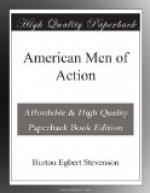The abdication of Napoleon had enabled England to turn her undivided attention to America, and one great force was sent against New Orleans, while another was concentrated in Canada, for the purpose of invading New York by way of Lake Champlain. On this latter enterprise, a force of twelve thousand regulars started from Montreal early in August, while the British naval force on the lake was augmented to nineteen vessels. On September 11, this fleet got under way, and, certain of victory, sailed into Plattsburg Bay and attacked Macdonough. A terrific battle followed, in which the Saratoga had every gun on one side disabled and had to wear around under fire in order to use those on the other side. But three hours later, every British flag had been struck, and the land force, seeing their navy defeated, retreated hastily to Canada. So riddled were both squadrons that in neither of them did a mast remain upon which sail could be made.
But the greatest victory of the war, the one which had the most important and far-reaching consequences, had been won a year before, far to the west, on the blue waters of Lake Erie, by Oliver Hazard Perry, at that time only twenty-eight years of age. Perry came of a seafaring stock, for his father was a captain in the navy, and the boy’s first voyage was made with him in 1799. At the outbreak of the war of 1812, he was in command of a division of gunboats at Newport, but finding that, owing to the British blockade, there was little chance of his seeing active service in that position, he asked to be sent to the Great Lakes, whose possession we were preparing to dispute with England.
The importance of this mission can hardly be overestimated. By the capture of Detroit, earlier in the war, the English had obtained undisputed control of Lake Erie, and were in position to carry out their plan of extending the Dominion of Canada along the Ohio and Mississippi rivers down to the Gulf, and so shutting in the United States upon the West. To Perry was assigned the task of stopping this project, and of regaining control of the lake.
He arrived at Lake Erie in the spring of 1813, and proceeded at once to build the fleet which was to sail under the Stars and Stripes. He showed the utmost skill and energy in doing this, and by the middle of July, in spite of many difficulties, had nine vessels ready to meet the enemy—two brigs and two gunboats which he had built, and five small boats which were brought up from the Niagara river. On the third of August, he sailed out to meet the British, his ships being manned by a motley crew of “blacks, soldiers, and boys.”
The flagship had been named the Lawrence, after the heroic commander of the Chesapeake. Luckily the English were not ready for battle, and Perry had a month in which to drill his men before the enemy sailed out to meet him. At last, on the morning of Saturday, September 10, 1813, the British fleet was seen approaching, and Perry formed his ships in line of battle.




